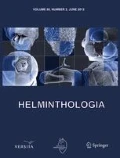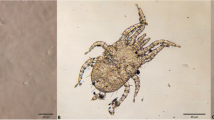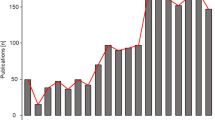Summary
During December 2007 and November–April 2008/2009, 128 gastrointestinal tracts and 1680 faecal samples of hares from different parts of the Czech Republic were examined. Evaluation of the faeces samples indicated that the samples could have been infected with any one of the following parasites: Eimeria spp., Trichostrongylus retortaeformis, Trichuris leporis, Graphidium strigosum, Strongyloides sp., Protostrongylus spp. and Anoplocephalidae tape-worms. Trichostrongylus retortaeformis was the most common nematode (75.8 %). 39.8 % of the animals were infected with Trichuris leporis. Only four hares were in-fected with Graphidium strigosum. Eimeria spp. was the most commonly occurring parasite (90.5 %). The follow-ing species were found: Eimeria coquelinae, E. cabareti, E. leporis, E. babatica, E. europea, E. pierrecouderti, E. macrosculpta, E. orbiculata and E. stefanski. Eimeria coquelinae was the most prevalent species (68.4 %). Eimeria cabareti and E. leporis were the next most frequently found species (64.5 % and 57.8 %, respectively).
Similar content being viewed by others
References
Allgöwer, R. (1992): Der Parasitenbefall von Feldhasen aus der Oberrheinebene und seine intraspezifische Bedeutung. Z. Jagdwiss., 38: 116–127. DOI: 10.1007/BF02286501
Aoutil, N., Bertani, S., Bordes, F., Snounou, G., Chabaud, A., Landau, I. (2005): Eimeria (Coccidia: Eimeridea) of hares in France: Description of new taxa. Parasite, 12: 131–144
Böckeler, W., Mokhtari-Derakhshan, F. L., Pecher, W. T. (1994): Zur Parasitenbürde des Feldhasen (Lepus europaeus) in Schleswig-Holstein. Z. Jagdwiss., 40: 22–29. DOI: 10.1007/BF02241502
Bordes, F., Langand, J., Feliu, C., Morand, S. (2007): Helminths communities of an introduced hare (Lepus granatensis) and a native hare (Lepus europaeus) in southern France. J. Wildl. Dis., 43: 747–751
Bouvier, G. (1967): Les Coccidies rencontrées en Suisse chez le lièvre gris (Lepus europaeus). Ann. Parasitol. Hum. Comp., 42: 551–559
Broekhuizen, S., Kemmers, R. (1976): The stomach worm, Graphidium strigosum (Dujardin) Railliet and Henry, in the European hare, Lepus europaeus Pallas. In: Pielowski, Z., Pucek, Z. (Eds) Ecology and Management of European Hare Populations, Polish Hunting Association, Warsaw, pp. 157–171
Crofton, H. D. (1946): The ecology of immature phases of Trichostrongyle nematodes. II. The effect of climatic factors on the availability of the infective larvae of Trichostrongylus retortaeformis to the host. Parasitology, 39: 26–38. DOI: 10.1017/S0031182000083517
Dubinský, P., Vasilková, Z., Hurníková, Z., Miterpáková, M., Slamečka, J., Jurčík, R. (2010): Parasitic infections of the European brown hare (Lepus europaeus Pallas, 1778) in south-western Slovakia. Helminthologia, 47: 219–225. DOI: 10.2478/s11687-010-0034-7
Eysker, M., Kooyman, F. N. J. (1993): Notes on necropsy and herbage processing techniques for gastrointestinal nematodes of ruminants. Vet. Parasitol., 46: 205–213. DOI:10.1016/0304-4017(93)90059-V
Fettinger, V., Smulders, F. J. M., Lazar, P., Omurtag, I., Paulsen, P. (2010): Leison in thighs from hunted Brown Hares (Lepus europaeus) and microflora under vakuum-packaging storage. Eur. J. Wildl. Res., 56: 943–947
Forstner, M., Ilg, V. (1982): Untersuchungen über die Endoparasiten der Feldhasen (Lepus europaeus). Z. Jagdwiss., 28: 169–177. DOI: 10.1007/BF02241927
Haupt, W., Hartung, J. (1976): Endoparasitenbefall der Hasen aus der Umgebung von Leipzig. Monatsh. Veterinarmed., 32: 339–341
Chroust, K. (1979): A contribution to the determination and species representation of hare coccidia. Veterinářtví, 29: 507–509
Chroust, K. (1984): Dynamics of coccidial infection in free living and cage-reared european hares. Acta Vet. Brno, 53: 175–182
Jirouš, J. (1979): Some observations of hare coccidia from central and nortwestern Bohemia. Lesnictví, 25: 1015–1027
Kotrlá, B., Černý, V., Kotrlý, A., Minář, J., Ryšavý, B., Šebek, Z. (1984): Parasites of Wild Animals. Prague, Czech Republic, Academia, 191 pp.
Kutzer, E., Frey, H. (1976): Die Parasiten der Feldhasen (Lepus europaeus) in Östereich. Berl. Munch. Tierarztl. Wochenschr., 89: 480–483
Langrová, I., Makovcová, K., Vadlejch, J., Jankovská, I., Petrtýl, M., Fechtner, J., Keil, P., Lytvynets, A., Borkovcová, M. (2008): Arrested development of sheep strongyles: onset and resumption under field conditions of Central Europe. Parasitol. Res., 103: 387–392. DOI: 10.1007/s00436-008-0984-6
Levine, N. D. (1980): Nematode Parasites of Domestic Animals and of Man. 2nd Edition, Mineapolis, Minnesota, Burgess Publishing Company, 477pp.
Levine, N. D., Ivens, V. (1972): Coccidia of the Leporidae. J. Protozool., 19: 572–581
Miláček, P., Vítovec, J. (1985): Differential staining of cryptosporidia by aniline-carbol-methyl violet and tartrazine in smears from faeces and scraping of intestinal mucosa. Folia Parasitol., 32: 50
Nickel, S., Gottwald, A. (1979): Beiträge zur Parasitenfauna der DDR. 3. Mittleitung. Endoparasiten des Feldhasen (Lepus europaeus). Angew. Parasitol., 20: 57–62
Pakandl, M. (1990): Some remarks on the prevalence and species composition of hare coccidia. Folia Parasitol., 37: 35–42
Pellérdy, L. (1956): On the status of the Eimeria species of Lepus europaeus and related species. Acta. Vet. Acad. Sci. Hung., 6: 451–467
Pilarczyk, B., Balickaramisz, A., Ramisz, A., Ciechanowicz, J. (2008): Preliminary studies on parasitic fauna of hares introduced on the Chrzaszczewska Island, West Pomerania. Wiad. Parazytol., 54: 159–161
Ryšavý, B. (1954): A contribution to the recognition of indigenous and imported vertebrate coccidia. Českoslov. Parazitol., I: 131–173
Shimalov, V. V. (2001): Helminth fauna of the hare (Lepus europaeus Pallas, 1778) in the southern part of Belarus. Parasitol. Res., 87: 85. DOI: 10.1007/s004360000259
Soveri, T., Valtonen, M. (1983): Endoparasites of hares (Lepus timidus L. and L. europaeus Pallas) in Finland. J. Wildl. Dis., 19: 337–341
Statsoft, Inc. (2009). STATISTICA (data analysis software system), version 9.0. www.statsoft.com
Strauss, E., Pohlmeyer, K. (2001): Zur Populationsökologie des Feldasen. In Wo liegt der hase im pfeffer. Naturschutz und rote liste? — Jagd und Hege, NUA-Serminarbericht Band 7, 2001. Natur- und Umweltschutzakademie NRW (Hrsg.), pp 5–20
Wetzel, R. (1951): Vebesserte McMaster — Kammer zum Auszählen von Wurmeiern. Tierarztl. Umsch., 6: 209–210
Author information
Authors and Affiliations
Corresponding author
About this article
Cite this article
Lukešová, D., Langrová, I., Vadlejch, J. et al. Endoparasites in European hares (Lepus europaeus) under gamekeeping conditions in the Czech Republic. Helminthologia 49, 159–163 (2012). https://doi.org/10.2478/s11687-012-0032-z
Received:
Accepted:
Published:
Issue Date:
DOI: https://doi.org/10.2478/s11687-012-0032-z




